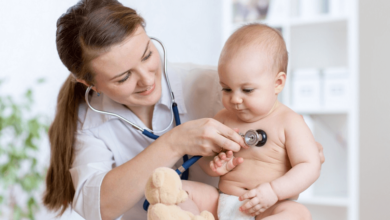Learn About Fever in Children

Introduction
It’s usually a sign that the body is fighting an infection or other illness. A normal body temperature is about 37°C (98.6°F). But a fever can make a child’s body temperature go up to 38°C (100.4°F) or more. Most fevers in children are caused by infections, such as colds or flu. Other causes of fever include: – Immune system disorders, such as autoimmune diseases – Cancer – Heatstroke – Medications, such as antibiotics or immunizations If your child has a fever, it’s important to monitor them closely and seek medical help if the fever lasts longer than three days or is accompanied by other symptoms, such as a rash. Read More
Causes of Fever in Children
There are many different viruses and bacteria that can cause a fever in children.
-Respiratory viruses, such as those that cause the common cold or influenza
-Certain medications, such as antibiotics
-Vaccinations
-Overheating, either from a high fever itself or from external sources such as being in a hot environment
In most cases, a fever is nothing to worry about and will go away on its own within a few days. However, there are some situations where a fever may be indicative of a more serious condition, such as meningitis or appendicitis. If your child has a fever that lasts longer than three days, is accompanied by other worrisome symptoms, or has a temperature over 103 degrees Fahrenheit, it is important to contact your doctor.
Symptoms of Fever in Children
Fever is a sign of illness, not a disease Bingo
If your child has a fever, it’s likely he or she is fighting off an infection. But how can you tell if your child has a fever? And what should you do about it?
Here are some common symptoms of fever in children:
• Your child feels warm to the touch. You may notice this when you touch your child’s forehead, neck, or chest.
• Your child has flushed cheeks.
• Your child has cold hands and feet.
• Your child is sweating more than usual.
• Your child’s body temperature is higher than normal. This can be measured with a thermometer. A rectal thermometer gives the most accurate reading for young children.
Treatment for Fever in Children
If your child has a fever, there are several things you can do to help them feel better. First, make sure they’re staying hydrated by giving them plenty of fluids to drink. You can also help them lower their body temperature by giving them a lukewarm bath or applying a cool compress to their forehead. If your child is having trouble sleeping due to their fever, you can give them children’s ibuprofen or acetaminophen to help relieve their symptoms.
Most fevers in children will go away on their own within a few days, but if your child’s fever lasts for more than three days or if they develop any other concerning symptoms, be sure to take them to the doctor for an evaluation.
When to Seek Medical Help for Fever in Children
If your child has a fever, it is important to monitor them closely. A fever is often the first sign of illness, and can be a sign of a more serious condition.
If your child has a fever and is under three months old, you should always seek medical help. If your child is between three months and three years old and has a fever over 102 degrees Fahrenheit, you should also seek medical help.
For fevers in children over three years old, you should seek medical help if the fever lasts longer than three days or if the child has any other symptoms, such as a rash, earache, or sore throat. If your child’s fever is accompanied by seizures, you should also seek immediate medical help.
Prevention of Fever in Children
Fever is a normal response of the body to infection or other illness. However, fever in children can sometimes be serious. If your child has a fever, it is important to monitor them closely and seek medical attention if necessary. There are also some things you can do to help prevent fever in children.
One of the best ways to prevent fever in children is to ensure they are up-to-date on their vaccinations. Vaccinations help protect children from many diseases that can cause fever, such as measles, mumps, and rubella. In addition, it is important to practice good hygiene habits. This includes washing hands regularly with soap and water and avoiding close contact with people who are sick.
If your child does develop a fever, there are some basic home treatment options that can help. These include giving them over-the-counter medications like acetaminophen or ibuprofen to help reduce their temperature and keeping them well hydrated by giving them plenty of fluids to drink. It is also important to monitor your child’s temperature closely and seek medical attention if it goes above 104 degrees Fahrenheit or if your child is displaying other serious symptoms like difficulty breathing or severe stomach pain.
Conclusion
If your child has a fever, it’s important to monitor their symptoms and seek medical help if necessary. In most cases, fevers in children are harmless and will resolve on their own. However, in some rare cases, fevers can be a sign of a more serious underlying condition. If you’re concerned about your child’s fever, it’s always best to err on the side of caution and speak to a doctor.




